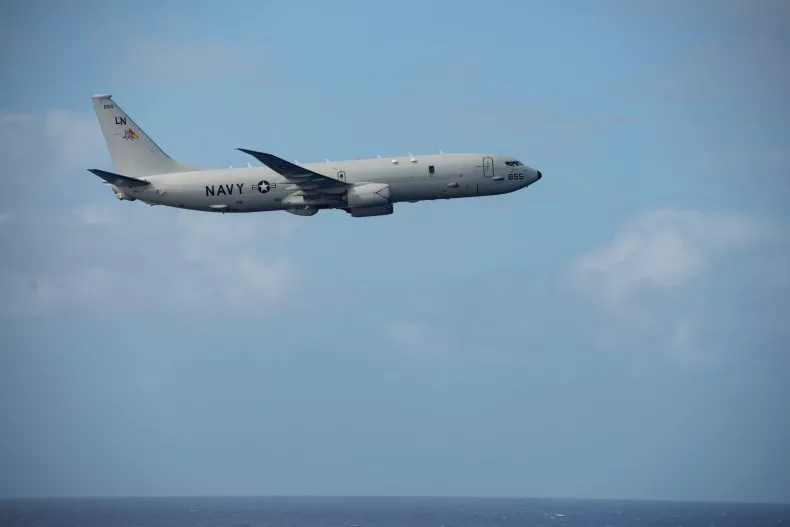AU.S. Navy reconnaissance plane flew down the center of the Taiwan Strait on Monday to assert its right to operate in international airspace amid opposition from China, which wants to push American forces out of the region.
The Navy’s Seventh Fleet said the P-8A maritime patrol aircraft transited the waters between China and Taiwan “in accordance with international law,” and to demonstrate “the United States’ commitment to a free and open Indo-Pacific. The United States will continue to fly, sail, and operate anywhere international law allows including within the Taiwan Strait.”
Taiwan’s defense ministry confirmed in a public statement that the U.S. military plane traveled from north to south through the waters, which are only 80 miles wide at their narrowest point. Taipei has no formal diplomatic relations with Washington, but counts it as the island’s largest arms supplier.
People’s Liberation Army Col. Shi Yi, a spokesperson for the PLA’s Eastern Theater Command, whose area of responsibility includes the strait, decried the P-8A’s overflight as sensationalism. “The U.S. action deliberately interferes with and undermines the regional situation and endangers peace and stability in the Taiwan Strait,” said Shi.
A P-8A maritime patrol aircraft flies by the aircraft carrier USS Nimitz on February 24, 2023, during operations in the Western Pacific. A U.S. Navy reconnaissance plane flew down the center of the Taiwan Strait on Monday.
In recent years, China has stepped up its opposition to U.S. military operations in its nearby sea and airspace. Last year, Chinese officials began publicly insinuating that foreign militaries had no right to operate in the strait, an argument largely predicated on its claim to sovereignty over Taiwan, which the democratically elected government in Taipei rejects, and which Washington doesn’t officially recognize under its one China policy.
Beijing’s attempts to push American operations further away from its shores have come in the form of what Washington says are riskier maneuvers in the air and at sea. These included a Chinese J-11 warplane that came within 20 feet of a U.S. Air Force RC-135 reconnaissance plane last month over the South China Sea, and a similar incident last Friday, also involving a Navy P-8A, witnessed by a traveling press pool on board the aircraft.
“U.S. Navy vessels and aircraft routinely interact with foreign warships and aircraft while operating throughout the region. All interactions with foreign military forces during the transit were consistent with international norms and did not impact the operation,” said Cdr. Hayley Sims, a Seventh Fleet spokesperson.
The Seventh Fleet, which is headquartered in Yokosuka, Japan, is responsible for missions that include asserting navigational and overflight rights in the Western Pacific. In the South China Sea and the Taiwan Strait, these tend to feature U.S. warships like the Navy’s Arleigh Burke-class destroyer USS Chung-Hoon, which transited the strait in early January for the first time this year, following nine other operations in 2022 by difference vessels.
Open-source aircraft-monitoring websites have tracked P-8A operations in the strait in the past, and the U.S. publicly confirmed at least one such transit in June last year. However, public announcements of this nature remain rare.
“While U.S. transits through the Taiwan Strait demonstrate our commitment to a free and open Indo-Pacific, we also consider them routine transits/flights through international waters and airspace. We issue statements to provide accurate and timely information in response to increased interest,” Sims said.
The contest between Chinese and American forces concerns the U.S.’s ability to operate freely in Asia, as Beijing aims to grows its military into the region’s dominant power in the coming decades. But Washington is also alarmed by China’s long-term designs on Taiwan.
The implications of a cross-strait conflict could have devastating consequences for the global economy that far outweigh the destabilizing effects of Russia’s war in Ukraine, according to officials including Secretary of State Antony Blinken.
“One of the reasons that the world is so concerned about a crisis across the Taiwan Strait is because this is not an internal matter, as China would have it, based on its sovereignty. It’s a matter of concern to quite literally the entire world,” America’s top diplomat told The Atlantic’s Jeffrey Goldberg last week.
“50 percent of the commercial container traffic goes through that strait every day. A big majority of the semiconductors that the world needs for everything from our smartphones, our dishwashers, to our automobiles are produced on Taiwan,” he said.
“If there were a crisis in Taiwan as a result of China’s aggression in some fashion, that would have I think disastrous consequences for the world economy and for countries around the world. And that’s a message too that Beijing is hearing increasingly,” he said.
Newsweek
Tags:US spy plane, Taiwan




